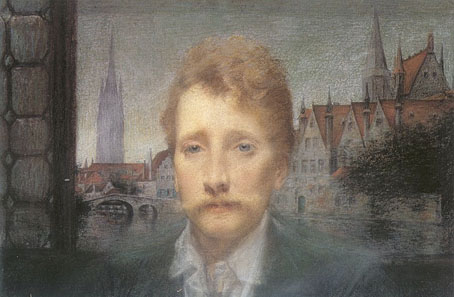
Portrait of Georges Rodenbach by Lucien Lévy-Dhurmer (1895).
Georges Rodenbach’s short, atmospheric novel is one of the key texts of Symbolism, not only for its themes but also for the art it either inspired or complemented. Bruges-la-Morte was first published in 1892 and the recent Dedalus Books edition, edited by Alan Hollinghurst and with a new translation by Mike Mitchell and Will Stone, was reprinted late last year.
Bruges-la-Morte…concerns the fate of Hugues Viane, a widower who has turned to the melancholy, decaying city of Bruges as the ideal location in which to mourn his wife and as a suitable haven for the narcissistic perambulations of his inexorably disturbed spirit. Bruges, the ‘dead city’, becomes the image of his dead wife and thus allows him to endure, to manage the unbearable loss by systematically following its mournful labyrinth of streets and canals in a cyclical promenade of reflection and allusion. The story itself centres around Hugue’s obsession with a young dancer whom he believes is the double of his beloved wife. The consequent drama leads Hugues onto a plank walk of psychological torment and humiliation, culminating in a deranged murder. This is a poet’s novel and is therefore metaphorically dense and visionary in style. It is the ultimate evocation of Rodenbach’s lifelong love affair with the enduring mystery and haunting mortuary atmosphere of Bruges.
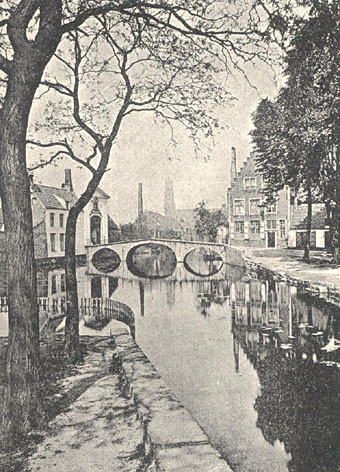
One of the Bruges-la-Morte photographs.
Bruges-la-Morte was one of the first (the first?) novels to incorporate photographs with the text and any decent edition of the book should always include these. Rodenbach’s novel is usually linked with French Symbolist artist Lucien Lévy-Dhurmer since the two men were friends and the artist produced the well-known portrait of Rodenbach shown above. Lévy-Dhurmer’s drawings and paintings of Bruges are a good match for Rodenbach’s writing, and one his Bruges pieces illustrates the cover of the Dedalus edition.
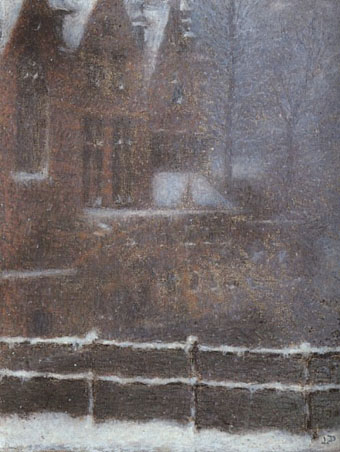
Bruges—Snow Effect by Lucien Lévy-Dhurmer (1900).
I usually contend, however, that it was another Symbolist artist inspired by Bruges and by Rodenbach’s novel, the Belgian Fernand Khnopff, whose work manages to be even more evocative than Lévy-Dhurmer’s, and consequently more suited to the theme. His touch was lighter and he had a superb ability to convey a sense of stillness and quiet mystery. (Coincidentally but unsurprisingly, both artists produced works entitled Silence.) Khnopff’s curious Abandoned City of 1904 (below), showing the sea flooding a town square, prefigures Surrealism and the haunted vistas of fellow Belgians René Magritte and Paul Delvaux.
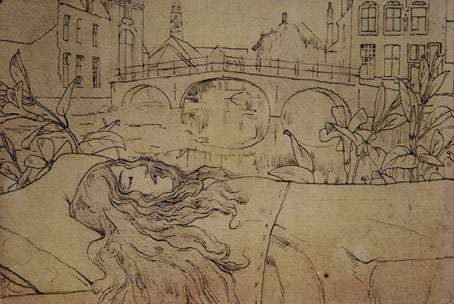
Bruges-la-Morte by Fernand Khnopff (1892).
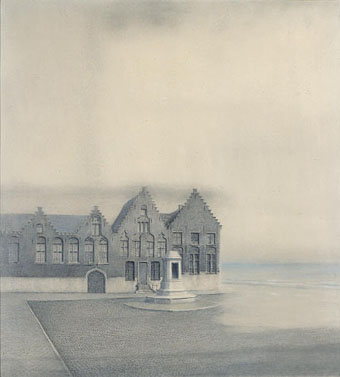
Une Ville Abandonnée by Fernand Khnopff (1904).
Dedalus Books has had its existence threatened recently due to proposed Arts Council cuts which would prevent the publisher from financing new translations of decadence and imaginative fiction. I’ve already signed their petition against this and I’d encourage anyone who cares for this kind of work to do the same. And if you’re feeling generous, you could always buy one of their books, of course.
See also:
• Bruges of sighs by Alan Hollinghurst
• Bruges, Paris and the spectres of Symbolism
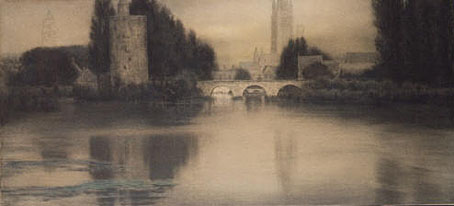
Le Lac d’amour, Bruges by Fernand Khnopff (1904–1905).
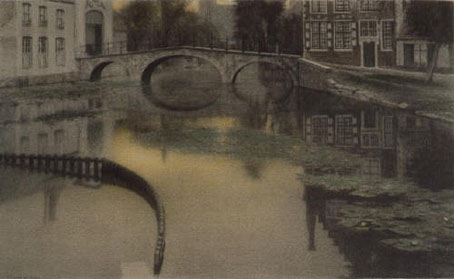
Souvenir de Bruges. L’entrée du Béguinage by Fernand Khnopff (1904).
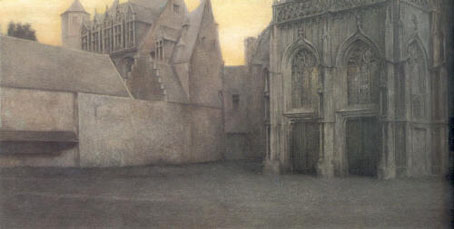
A Bruges. Un Portail by Fernand Khnopff (1904).
Previously on { feuilleton }
• Hugo Steiner-Prag’s Golem
• The art of Félicien Rops, 1833–1898

I wonder if Ballard was inspired to write the Drowned World after seeing some of the Khnoppf images you’ve shown?
I suspect Ballard’s inspiration for that came from deeper psychological reasons but he certainly knows about the Symbolists. The RE/Search book mentions him having my favourite Symbolism volume, Philippe Julian’s Dreamers of Decadence on his shelves and I’m sure he mentions Moreau in his short stories. He definitely references Paul Delvaux.
Something to discover!!
Yes, I’d also love to discover Bruges itself. I visited Belgium years ago but didn’t get to see any of its finest cities.
I just signed the Dedalus petition – thanks for the reminder.
I always liked the art that Bruges-la-Morte inspired rather better than the book itself: Une Ville Abandonnée is one of my favourite of Khnopff’s paintings.
I’ve always preferred the paintings as well. Having said that, I ought to give this new translation a look, the edition I read years ago probably wasn’t too reliable.
Lovely post. I adore Bruges, this book, and the opera it inspired, and link to your post this morning.
Yes, I suppose it’s more hip and cool and all to say you prefer the paintings to the book. *laughs* Perhaps that’s because images are more easily assimilable in our own decadent–in the worst possible way– era than is poetic prose.
There’s hip and cool, and then there’s honest opinion. Mine was the latter which your carping tone seems unable to accept.